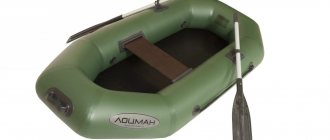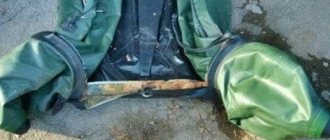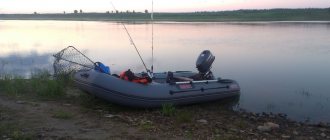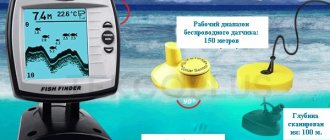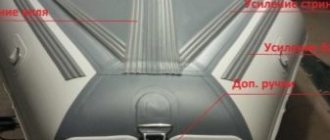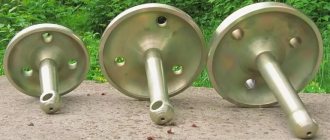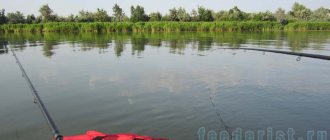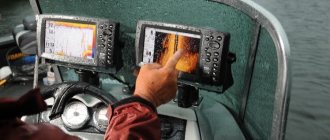The Crimea boat, version 3, is designed for recreational purposes and family trips and can accommodate 5 people. It has a cozy, comfortable and spacious living space. Can be equipped with a rigid removable deckhouse. It has all the necessary factors for planing and excellent driving characteristics. Designed for 2 outboard engines with a total power of 50-60 hp. With. The glider belongs to the luxury class models of the Soviet era. Seaworthiness is ensured thanks to the contours and aluminum alloy, resistant to salt water. It is possible to spend the night on the ship.
The Crimea 4 boat is a product of another plant located in Feodosia. This is a representative pleasure plastic boat with a water-jet propulsion and a cabin, produced during the Soviet period. There was a “4P” variety, also plastic, high-speed, designed for a 110-horsepower PM.
Advantages
- The best thing about using this boat is comfort. It shines through literally everything. The design engineers carefully thought through every detail: a gate in the windshield, steps to climb onto the deck, plenty of places for personal belongings and tools, a folding table, comfortable sofas and seats. According to the creators, this should be a “house on the water”, in which travel becomes enjoyable even with small children
- The metal cabin, which manufacturers suggested ordering additionally, provides protection from sunlight, wind, splashes, etc. It has an upper hatch for ventilation. The height of this design is quite acceptable for people of average height. However, for a man over 195 cm there is not enough space. The cover is locked with a padlock, protecting the vehicle from uninvited guests
- A very spacious deck where passengers will have the freedom not only to ride, but also to sleep. Foam mattresses cover the folding bunks, which are up to 1.75m long.
- Since all luggage is placed in an extensive storage system for things and equipment, nothing lies underfoot and does not impede the passage to the stern, which, in turn, is free due to the successful placement of longitudinal lockers
- The fuel compartment is a captain’s dream, because it holds 7 containers for fuel with a standard volume of 20 liters at that time.
- The glider is not afraid to go against the oncoming wave due to the keeled contours of the bottom and sides, which have a good height
- Corrosion resistance ensures long service life of the model
- The product is designed for 2 fairly strong engines. Accordingly, its speed characteristics are tempting for lovers of fast walks
- “4” are distinguished by their speed capabilities and good planing ability
Motorboat "Crimea". The invincible legend is still in the lead today
A short article about this legendary boat. First the pros. Cons - at the end of the article. They exist too. If anyone wants to discuss, write in the comments. Sometimes reading them is more interesting than the article itself.
Main characteristics of the boat "Crimea":
Length 430 cm. Width 160 cm. Deadrise angle at the transom 4.5 degrees. Weight 190 kg. Load capacity 400 kg. Max. permissible power 30 hp
Almost 50 years ago, the production of this legendary boat began! Many of my friends have “Crimea”s, who are 40 years old. My boat was born in 1990. I bought it in 2011. And so far there are no plans to exchange the “Crimea” for another boat.
Before him, I had several Soviet motorboats - Ob3, Kazanka 5m3, Kazanka 5m2, Progress 4.
I have a boat for spinning fishing on the Ob. I fish not far from the city. And sometimes I go away for several days, down or up the river. Here is an article about spending the night in this boat.
After the purchase, for a couple of months, I drove around under the fifteenth Merck that was left over from the PVC boat. Even with such an engine, "Crimea" goes on plane - with two people and a small load of things. When one person (driver) sits at the stern. Moreover, the engine is a tiller.
“Crimea” in general loves stern loading. If the main weight of the load is at the back, the boat planes, as they say, “on the heel.”
The maximum permitted engine power for this boat is 30 hp. Sometimes they give 40 or even 50 (if GIMS doesn’t mind). But more than 40 hp. - there is no point. The speed is more than 55 km/h, you are unlikely to be able to increase it.
On my Suzuki DT 30, on smooth water and on a standard propeller with a pitch of 13, I could only accelerate to 49 km/h. I have a boat for fishing. And I'm not a racer. Just experimenting.
Here, in the video - 47. But the boat was decently loaded. I didn’t make the video to show speed. And to show your friends the evening Ob.
I apologize in advance, the wind is making noise in the microphone of my mobile phone (which I used to shoot the video).
With a pitch 12 propeller (Solas), the motor on this boat easily turns 6000 rpm. The speed does not rise above 36-37 km/h. (alone in a boat, lightly loaded - on smooth water). But in planing mode, it jumps out, just instantly. This is my “cargo” version of the propeller.
The Crimea boat is made of AMg 5 (aluminum-magnesium alloy). Compared to duralumin (from which most Soviet riveted boats were made), AMG is distinguished by its high ductility. With strong impacts, this material bends and does not break - as often happens with duralumin.
(about how I installed the echo sounder and protected the devices from power surges -
in the article, follow this link )
I don’t use the engine compartment cover (it was designed so that it was possible to put the engine in it during storage). Without it, this compartment can accommodate more than just gas tanks. But there are also many things that can stick out upward. But the lid wouldn't allow it.
I don’t consider the fact that there is no self-draining recession to be a problem. Yes, it rains a little. Sometimes there is a wave, if a huge boat has passed, and the Crimea is moored - with its stern to the wave. But between the cockpit and this compartment there is a sealed bulkhead. And the electric pump works properly. So it's not scary.
The hull of the Crimea boat is welded (there are rivets only on the fender beam - in the surface part). Therefore, as these boats age, they do not begin to drink water.
There is quite a lot of space in the cockpit (its dimensions are 2.05 x 1.3 m), despite the modest size of the boat itself. It’s quite enough for fishing alone or with two people.
“Crimea” is convenient for various tunings. It can not only be sawed and drilled (but still, try to “shred” the boat as little as possible). But also weld it later, cut it or make a hole. AMg welding is performed using the argon arc welding method.
You say I only praise “Crimea”?
No))) About the disadvantages - at the end of the article.
If you're interested, here's an article about how the boat was painted
. About processing, choice of paint.. Then - a little tuning (awning, seats, etc.). Here is the first half of tuning. There are several in this photo (you can scroll through)
The hull of the boat is very strong and reliable. Despite the fact that it is not the thickest (by today’s standards) bottom (2mm), “Crimea” can withstand impacts on large waves (up to 0.75m high). True, you won’t envy the passengers on the boat)))
The stem does not bend or break when hitting an unnoticed driftwood or when hard mooring to the shore. Properly calculated, wide splash guards - no splashing on the wave. The glass has an angular, outdated shape, but it does its job. You can look over the glass - and the flow of wind beats above your head.
It is advisable to strengthen the transom of the boat, even if the engine power does not exceed the permitted 30 hp.
And keep an eye on these junctions between the transom and the hull. Without reinforcement, they can burst (cracks appear). For those interested, there will be a detailed article about this.
Subscribe to the channel so you don't miss it. Despite the highest corrosion resistance of AMG, electrochemical corrosion of aluminum occurs in places where aluminum comes into contact with most metals.
Flaws
- Despite the large list of undoubted advantages, there is a minus that offsets the merits of the designers - a weak bottom. Before the serial number 1000, the factory workers managed to produce products of excellent quality, which are still regularly serving their owners. Then it was decided to replace full-fledged redans with corner ones. As a result of such rationalization, the bottom of the vessel became afraid of hitting the water. Cracks began to appear in the area of the false walls, due to which the owners had the opportunity to see cracks and moisture leaking inside
- A warning follows from the previous drawback: a careless owner of such an exclusive model will “kill” it within a season. You need to constantly check the condition of the bottom. Otherwise, deformations and defects will become irreversible. Cracks must be repaired: riveted or welded immediately. The situation can be corrected by thorough tuning of the lower part of the body
- Speeding at “full” power, permissible according to the passport, aggravates the condition of the motorboat. Impacts on the water surface fall more on the stern and the corners come off, 60 forces is too much with such a disadvantage. For long-term use of the watercraft, it is necessary to adhere to a ceiling of 40 to 45 liters. With.
- The windshield allows moisture into the cockpit during thunderstorms and rainy weather
- The transom must be adjusted to modern PM, raising it to the required height
- The reverse and throttle remote control cables are not long enough, there are inconveniences in controlling them
- According to complaints from owners of version “4”, an extremely unsuccessful water cannon was installed on it. Also, the plastic wore out quite quickly. There were complaints about the condition of the buoyancy blocks
- Separately, for the above-mentioned boat, it is worth noting the reliability of the power set: the ready-made molded set was glued with wet corners. From the 2 stringers, not whole frames, but frames consisting of pieces are attached to the sides. What remains of such an assembly after some time can be seen in the photo
Time-tested advantages of “Crimea”
This vessel has been in operation for decades and during this time has truly proven its stability and reliability. Of the “eternal” advantages of the Crimea boat, the following should be highlighted:
- Increased body strength. The alloy used is strong on its own, but when combined with strong seam welding, the design becomes even more durable.
- Relatively light weight . For such a vessel, a figure of 190 kg is quite optimal, especially when compared with other metal craft.
- Opportunity to go out to sea. The boat does not “dive” into the wave, and holds up well in light rolling.
- Planing. The low deadrise of the hull allows the boat to easily plan even with a heavy load and a weak engine.
These are the properties for which the boat became famous and is still readily bought second hand in almost any condition.
History and goals of creation
The boat series appeared thanks to the talented designer G.V. Nelipa, who took one of the prizes in the well-known competition for small watercraft projects. The idea of the young engineer was developed in 1970 in Perm at a shipbuilding plant. From 1970 to 1980, the first modification was made. All the 80s and the first half of the 90s. Perm and Khabarovsk enterprises produced versions “1” and “M”.
The products became widely known and were actively sold out in stores. Buyers demanded a continuation of the successful series, and the designers of the Neptune Central Design Bureau, one of whom, V.A. Basnin, voiced the “family” orientation of the new product, set about creating a new modification. In 1978, at the races in Liepaja, model “3” was presented to the public for the first time, which received positive reviews from experts, as well as 2nd and 3rd places in the T-700 and T-1000 classes. By the day of the competition, the plant managed to produce 50 units of goods. A year later, the serial representative was already distributed in full.
The version with a cabin was planned as a full-fledged modification, but the demand for it turned out to be small, and the attachment became an element that was separately ordered from the catalog. 1984 was marked by the premiere of the fourth production line. The main difference was the installation of a water cannon based on the ZMZ-24-01 automobile engine. Project manager V. Nelipa received from the Central Research Institute. acad. A. N. Krylova gave the motor the highest rating - an excellent level of efficiency. The duration of production of “4” and “4P” was short, so these copies are rare, it is difficult to buy or repair them due to the lack of spare parts and experience with them. In the 80s and 90s, interest in these products gradually faded, and the entire series stopped.
Video boat Crimea 3:
A little about the boat “Crimea” and its modifications
The first sketch of this vessel was demonstrated to the general public in 1969, when the talented engineer V. Nelipa presented his project to the competition of small vessels. He did not take the main prize, but received a prize and attracted the attention of major shipbuilders. Therefore, already in 1970, the motorboat “Crimea” hit the shipbuilding conveyor (Perm). Later, along with Perm, a shipyard in Khabarovsk was involved in the production of the vessel, and a couple of modifications were also developed, but we’ll talk about this a little later. Now we invite you to find out what characteristics and features the original motor boat “Crimea” is endowed with.
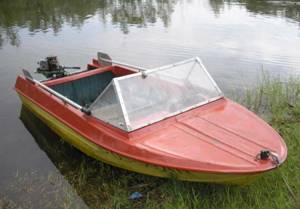
Boat design and main design nuances
The hull of the vessel is made of an alloy of aluminum and magnesium (AMg5), which ensures the strength and wear resistance of the boat. The seams of the parts are processed by welding, but riveting is also used for a small part of the connections. In addition, it should be noted the stamping of sheet parts and the “cut-to-sleeve” assembly method. The casing is made of metal sheet with a thickness of 1.5 mm on the body and 2 mm at the bottom. At the same time, the Crimea boat is distinguished by its convenient dimensions and low weight.
Thus, the length and width of the Crimea boat are 4.2 m and 1.6 m, respectively. It is noteworthy that the dimensions of the “Crimea” hull can be reduced, because Structurally, the boat is made up of 4 sections. If desired, you can disassemble the hull and eliminate one or two sections, thus reducing the overall dimensions of the vessel. But to reconnect the parts, you will need argon welding, which is used to process aluminum sheets. So such tuning is possible, but due to its high complexity it is rarely applicable.
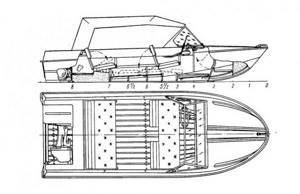
If we talk about how much the Crimea boat weighs, then everything here is also quite pleasant. Considering that the hull is made of a durable metal alloy, and the dimensions are quite large, the weight of the boat is small. Thus, the dead weight of the Crimea boat together with the installed equipment is only 190 kg, which makes it easy to handle the vessel during transportation, grounding and in other situations. At the same time, the vessel’s carrying capacity is designed for 400 kg, which is enough to transport 4 passengers and additional cargo.

And finally, the design of the boat is distinguished by its color variety. Up to the fender level, the Crimea boat was covered with red paint, and the sides and bottom were highlighted in bright yellow. The inside of the metal body was usually treated with gray enamel with shimmering light blue tones. Also quite common was the design of the case in green shades and khaki style. Today, each owner can easily design a vessel to his own taste, so this selection criterion is no longer relevant.
Distinctive features of the boat "Crimea"
This model is universal in purpose: the Crimea motor boat is suitable for walking, for high-speed racing, and for fishing and hunting. With minimal weight, the boat moves at a speed of 36 km/h, and when fully loaded, the average speed drops to 30 km/h. You can travel on a vessel along rivers, lakes and coastal sea lines, but only if the wave height does not reach 0.75 m (waves up to 3 points), and the distance from the shore does not exceed 3 km. Such performance characteristics of the Crimea boat are ensured by the dimensions and well-thought-out structure of the vessel. When developing the boat, engineers were guided by the following principles:
- Focus on increased strength properties of materials.
- Finding the ideal ratio of body length and width.
- Ease and reliability of control.
- Maximum useful use of cockpit space.
- Convenience of passengers on board the ship.
You might be interested: Russian-made motor boats and boats - a review of manufacturers
For these purposes, all components of the hull were carefully designed, and much attention was paid to the strength of the bottom.
The bottom of the boat is reinforced with stamped frames, and additional rigidity is provided by assembling the frames with stringers using a mixed method. In addition, the hull has special contours, the convex-keel shapes of which give the boat increased hydrodynamic properties. Together with a wide spray deflector located at an angle of 90° to the sides, these parts provide high speed of the vessel and minimize shaking, hesitation, off course and splashes on the deck.
The bow of the vessel is decked and decorated with stiffening ribs. The cockpit is open, but is protected from splashes by a windshield with side shields. The cockpit space is 2.05 m long and 1.3 m wide, which made it possible to conveniently place the control panel and create spacious and economical passenger seats. Thus, the driver and passenger seats are equipped with reclining backrests and a swivel mechanism, and the aft sofa is a “lid” of the luggage compartment. The bench comfortably seats 2-3 people, while under the bench there is space for transporting a boat motor. All seats are removable and, if necessary, you can place them on the floorboard, creating a wide bed for 2-3 people.
And speaking of engines. "Crimea" is equipped with a remote steering control, which makes it easy to start the engine, maneuver and quickly stop the boat. There is a transom for the engine, separated from the cockpit by a watertight bulkhead. Moreover, both the bulkhead and the transom are equipped with drain valves, which can be opened when the boat is moving. Next to the partition there is the already mentioned compartment provided for storing the motor in the “across” position.
Also worth mentioning are the foam buoyancy blocks attached under the bow and stern of the Crimea. They allow the boat to stay afloat evenly during heavy flooding. It is strictly forbidden to remove the blocks before going out on the water, because... This will result in instability and the risk of the vessel capsizing.
It remains to add that, complete with the boat, the buyer received a canopy, a set of sleds, 2 oars, spare buoyancy blocks and other components. Of course, if the used Crimea boat passed through more than one hand, most of the accessories will probably be lost, but due to the scale of production, original components can still be found on the secondary market. However, you can also easily replace them with modern materials.
It is for these distinctive features that this vessel has been loved by many since the time of its first release in 1970. Later, the design continued to be improved, and eventually, from 1970 to 1992. The Crimea motorboat was produced in three versions. There was even a fourth modification, but they did not have time to release it for wide consumption. So, let's talk in detail about the three versions of this famous vessel.
Characteristics table
| «3» | "4P" | «4» | |
| Maximum length, m | 4,7 | 5,5 | 5,5 |
| Maximum width, m | 1,8 | 2,08 | 2,08 |
| amidships | 0,8 | 1,0 | 1,0 |
| in the nose | 0,75 | ||
| aft | 0,73 | ||
| Deadrise angle: | |||
| bottoms amidships | 15 ° | ||
| bottoms on transom | 7 ° | 12 ° | |
| Weight with equipment and supplies, kg | 245 | 870 plus or minus 30 | |
| Passenger capacity, persons | 5 | 5 | 5 |
| Load capacity, kg | 500 | 450 | |
| Total displacement, kg | 745 | 1280 | 1350 |
| Permissible PM power, l. With. | 50—60 | 110 | 70 |
| Housing material | AMg5V | fiberglass | fiberglass |
| Assembly technology | welding |
Appearance and design features
«3»
"Crimea 3" is made of AMg5V - a metal with high strength, ductility and resistance to corrosion processes. The assembly method is mixed, including argon-arc welding and a small percentage of riveting. The hull has sharp cheekbones and convex-keeled contours with a moderately increasing deadrise angle from 7° at the stern to 15° in the midship area. 4 longitudinal corners are welded to the bottom, performing the function of redans.
The forepeak has a spacious luggage compartment, accessible through a sealed bomb bay on the deck. It is isolated from the cockpit by a solid bulkhead. It is necessary to note a nice detail of the windshield - the “Window”. The driver's seat is located slightly unusually, on the right side, which eliminates the appearance of a roll during travel. The habitable space is arranged according to the principle of ergonomics: every centimeter must be used, and every object must work. To increase the usable volume of the cockpit, the creators completely removed the side footrests, thereby adding up to 3 cm of usable internal area.
Passenger seats are provided by two longitudinal lockers located along the sides and one transverse locker in the aft part. The first are structural elements of rigidity. They have dimensions of 1.3 by 0.45 m, and each of them is divided into 2 seats by a vertical removable backrest, upholstered in soft material. Thus, the front passenger and his companion sit with their backs to each other.
The backrests, with the assistance of hinged fasteners, are inserted into the empty spaces between the aft and side cans. This creates 2 sofas for sleeping, 1.58 m wide and 1.75 m long. A mattress filled with foam rubber is placed on top of them. This solution is applicable both for the formation of berths and as an opportunity to place 3 people on one side. Considering this method of seating, you can take 7 passengers on the ship.
The right side wall is equipped with a folding table. When folded, it hides under the lid of a can near the aft bulkhead. The side surfaces have niches for storing various things and personal belongings. To make it easier to climb onto the deck, the developers carefully attached a shelf-step, which can be used as a stand for camp kitchen tiles. The gas/reverse remote control is mounted near the steering control, at arm's length. The panel has a niche and a lockable glove compartment. The compartment in the stern bank, located at the transom with the under-engine niche, has an excellent volume: it can accommodate up to 7 fuel tanks of twenty liters each. The transom assumes the installation of 2 engines of equal power or at the discretion of the owner, but within acceptable limits.
For some time, the plant produced variation “3” with an extension made of a light alloy based on aluminum. The height in the deckhouse above the decks to the bottom of the ceiling is 120 cm. From the captain's chair to the roof above his head is 95 cm. In bad weather, the ship's inhabitants are protected from the elements on all sides: the top is covered with a ceiling with a hinged lid, and it is attached to the rear part a panel acting as a door on the stern side, with sliding glass on the sides. If you fold the rear partition onto the forepeak, you get an open cockpit, hiding only the 2 front seats under the canopy. The cabin can be securely locked. This modification is 30 kg heavier.
«4»
Photo of the boat Crimea 4:
From the very first copy, the series has evolved in accordance with modern trends. The Crimea 4 boat is a completely new story. We need to start with the fact that the material in this case was fiberglass. The hull has full bows above the waterline. On the bottom there are 3 pairs of redans, having different lengths and ending in the midsection area. The bottom deadrise at the transom is 12°. The power set is cast from fiberglass: two longitudinal stringers and frames glued to them, consisting of two halves.
The bow is decked and smoothly transitions into a collapsible deckhouse. Once dismantled, its parts are placed under the floors and behind the side protection. On the side pillars it is possible to place a roof of varying degrees of closure, up to a lockable door. The dimensions of the cockpit are 3.2 x 1.6 m. The usable space is increased due to the fact that the engine is moved to the right towards the transom, in the corner. The rear bench is molded as one piece with the engine housing covered by a plastic hood hinged to the transom. Folding chairs can be mounted anywhere in the interior space.
To protect the water cannon pipe, the developers used a rather interesting solution: a mini-deck was cast around it as a protective casing, preventing various types of damage. It is convenient to go ashore along it through the stern. Luggage compartments are located in the bow, in the side shelves, and in the aft locker. Under the hood is a ZMZ-24-01 engine, borrowed from the Volga GAZ-24 car. The fiberglass conduit is shallow and short. The grate that collects water is recessed into the bottom, which makes travel safer. The inspection hatch is built into the water pipeline. Metal parts are cast from stainless steel.
“4P” had a similar structure, the only differences of which were: the presence of a suspended unit, since the water-jet installation turned out to be short-lived and quickly failed, a folding rear sofa and 2 front seats, a ladder with handrails on the transom. The reason for the changes was that the Crimean industry began to demand that the factory workers replace the engine with an outboard one, but at the same time not inferior in power and speed characteristics to the prototype.
General location of the Crimea-3 motorboat
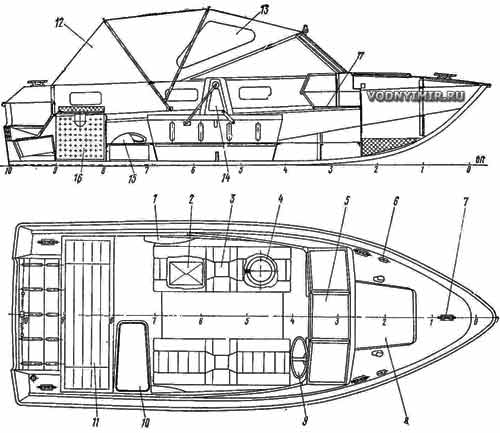
1 - oars; 2 — first aid kit for repairs; 3 — side locker-seat; 4 — ring with a rescue line; 5 - opening windshield flap - “window window”; 6 - oarlock; 7 - duck eye; 8 — bow trunk hatch; 9 — steering remote control; 10 — removable table; 11 — aft sofa; 12 — soft folding awning; 13 - window made of wrinkle-resistant film; 14 — reclining backrest of the side seat; 15 - scoop; 16 — aft trunk for fuel storage and aft buoyancy blocks (on the sides); 17 - shelf-step for access to the bow deck.
Here is a brief description of the serial "Crimea-3". The boat has a riveted-welded hull made of aluminum-magnesium alloy AMg-5V. The hull material allows the boat to be used in sea water. The principle of combining in one structural element the functions of a hull design part and a part of the structure or equipment was used to the maximum extent. This made it possible to significantly reduce the weight of the structure (the “naked” body weighs 130 kg), the number of parts and the length of connections.
Convex-keeled contours with a moderate deadrise of the bottom were used (15° at the midships, 7° at the transom). The dimensions of the boat were taken to be the maximum possible according to production conditions, but at the same time with the expectation of the possibility of ensuring high speed (with a given load capacity of 500 kg) with motors of power acceptable to our lovers (2 x 25 hp).
The fundamental layout solution is traditional for most of our motorboats. The forepeak, used as a bow trunk, is separated from the cockpit by a solid bulkhead on the shank. 2.5. The hatch cover in the bow deck is splash-proof. The main equipment of the cockpit consists of three lockers (two longitudinal and aft transverse). The side locker seats (dimensions in plan are 1.3 x 0.45 m) are equipped with backrests, which are mounted on hinges and, when equipped with a berth, recline towards the stern - into the opening between the side and stern lockers.
The result is a berth 1.75 m long. In a vertical position, the backrest divides the locker into two seats “back to back”. Foam mattresses are attached to the upper stamped lids of the lockers. The lockers themselves serve as spacious trunks. The situation of many boat owners is taken into account: the forepeak and all lockers can be padlocked if necessary.
Transverse aft locker between the sub-engine niche and the bulkhead on the spline. 8 is intended for fuel storage. This includes seven standard 20-litre jerrycans; Thus, the normal gasoline supply is 140 liters.
The aft locker is equipped with a stamped lid that opens from the cockpit. A foam mattress is also placed on it, so that the locker serves, if necessary, as a seat for three people or an additional bed.
There are seven seats in the cockpit; The passport passenger capacity (five people) is determined by the carrying capacity. Naturally, “Crimea-3” will be the most comfortable vessel with a crew of four, and during long passages, three people. On the starboard side, in the opening between the side and stern lockers, a removable table can be easily installed. In the stowed position, it folds and is fastened to the lower surface of the aft locker lid. The box-like structures of the sides provide storage space for soft items or small items. Soft items can also be placed in the hollow backs of side lockers.
There is provision for boarding and disembarking from the boat through the bow deck. For this purpose, the middle section of the windshield is made to open - tilting towards the nose and to the left side, and in the forward part of the cockpit under the “window” there is a kind of shelf-step. In camping conditions, it is convenient to install a portable gas stove on this step.
The control station is located on the starboard side. This made it possible, firstly, to compensate with the driver’s weight for the roll caused by the reaction torque when operating the propellers, and secondly, to place the remote control of the gas and engine reverse under the driver’s right hand. At the same time, the design of the side, aft part of the deck section and the entire “front panel” is made completely symmetrical relative to the DP, so that, if necessary, the steering can be mounted on the port side - as usual. In the standard version, there is a cabinet on the left side of the panel. Above the shelf-step in the vertical wall there is a niche convenient for storing small items.
To protect from bad weather, the Crimea-3 motorboat is equipped with a soft awning, which has stern and side windows made of transparent, wrinkle-resistant film. In the front part of the awning there is a valve-hatch fastened with zippers, which allows you to exit the boat onto the foredeck when the awning is installed. The rolled-up awning and arches are folded to the enclosure of the engine niche so that they do not interfere with the maintenance of the engines and do not spoil the silhouette of the motorboat with a “hump”. The boat's unsinkability is ensured by foam blocks in polyethylene covers, placed in the bow (under the decking in the forepeak) and in the stern - in the aft locker.
The subkeys are installed in front of the windshield. You can row by opening the middle wing of the windshield and sitting on the forepeak hatch cover, back forward, with your feet on the step. Of course, this is not the ideal rowing position, but it is possible to move short distances.
The motorboat is equipped with distinctive, masthead and tack lights, which are turned on from the boat control station. Here on the remote control there is a socket for installing a remote tachometer (vehicle device).
Tests and operation of prototypes of the Crimea-3 showed sufficient seaworthiness of the motorboat and satisfactory driving performance.
Scheme
Equipment and accessories
The glider number “3” is equipped with:
- 2 oars
- repair kit
- 2 side lockers and 1 stern locker
- steering remote control
- duck eye
- rowlocks
- awning with a polyethylene window and arches for its installation
- wicket wind protection system
- with a ladle
- folding table and soft seat backs
- rescue line
- buoyancy blocks
- running lights
- soft mattress for sleeping places
- shelf for lifting to the deck
The improved model was equipped with a wheelhouse consisting of a roof with a hatch, a rear panel, and windows.
The equipment of the fourth series was almost not covered in periodicals; there is practically no data on equipment. The set included: a collapsible plastic cabin, remote control and steering wheel, lockers, a soft sofa in the rear half of the cockpit, a table and non-stationary chairs, a windshield and a hood.
Characteristics of the boat "Crimea-3"
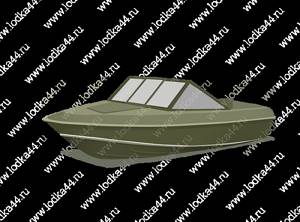
General information The Crimea-3 motorboat was developed in 1978 by the Neptune Central Design Bureau. When designing this model, the developers paid the greatest attention to such characteristics as safety and spaciousness. The main purpose of the vessel is a weekend boat trip. In addition, a modification of the Crimea-3 motorboat was produced, equipped with a rigid deckhouse, which had a mass of 30 kg. An aluminum-magnesium (AMe5V) alloy was used in the manufacture of the hull and deckhouse. It should be noted that the deckhouse was designed taking into account increased comfort for the crew, which is why its height was increased, which was not typical for motorboats of a similar class.
Hull The vessel has a sharp-cheeked, domed-keeled hull of riveted-welded construction made using marine grade aluminum. The thickness of the bottom is 2 mm, the thickness of the sides is 1.5 mm. In addition, the hull's unsinkability is ensured by built-in foam buoyancy blocks located under the aft locker, as well as in the bow of the cockpit.
Cockpit “Crimea 3” has a car-type cockpit. In addition, the vessel used advanced layout solutions for that time - a folding “gate” of the windshield, as well as a relocation of the steering column. By installing the steering position on the starboard side, the developers solved the problem of boat roll, which appears as a result of the action of propellers with a crew consisting of one driver. We made a more convenient grip for the lever under the right hand to control the throttle, since, as a rule, motorists are right-handed. In addition, the developers abandoned the side decks in favor of increasing the area of the internal cockpit. This made it possible to board/disembark the team through the bow deck using a folding “gate” located in the glazing structure. The luggage compartment is separated from the cockpit by a bulkhead, and is accessed through a lid located in the deck. Despite the fact that the crew of the Crimea-3 motorboat allows only five members, there are seven seats inside. It is worth noting that the front seats are double and can be folded out, while sleeping places with a length of 175 cm are created along the sides. There is also a folding table behind the right seat.
Habitability
"Crimea 3" is one of the best ships in terms of comfort, justifying the purpose of its creation. For trips with a group or family, the engineers have provided maximum comfort: from the moment you get on deck until you spend the night. The abundance of compartments for storing luggage in the forepeak, in the side walls and in the sofas allows you to maintain order in the cockpit. As a result, all things are in their places, nothing is lying underfoot. The hatch in the decked part is wide for easy access to equipment and tools. The storage system, with a total volume of 0.84 m3, is secured with padlocks.
The area of the living compartment is 4.74 m2. According to the documents, there are 5 passenger seats, but in case of need, Nelipa’s team provided 2 spare seats. Four riders sit on the side lockers facing away from each other, leaning on the backrests covered with foam rubber. The rear sofa can accommodate one more person. Equipping a sleeping place is quite easy: the backrest with fastenings in the form of hinges is simply pulled into the free space near the transverse sofa. It turns out to be a full-fledged bed for an adult.
A blanket stuffed with soft material is placed on top. So at least 2 inhabitants can relax or spend the night on board. But the bonuses didn't end there. On one of the sides, in the opening between the side seat and the stern seat, a tabletop is attached. In the reclined position, it performs its function perfectly. The windshield has a door in the middle, so desired by owners of other well-known brands. The steering wheel is initially located on the right, but installation on the other side is also possible.
Access to the forepeak is achieved using a small drawer that functions as a step and a stand for a camp cooktop. There is a cabinet under the dashboard in the control panel, and on it there is a recess for the tachometer. The soft folding awning is mounted on arches, has transparent inserts, and a zippered hatch for access to the deck. When folded, the cape takes place at the recess fence.
For a design with an aluminum deckhouse, the extension is sold disassembled. If there is no need to assemble it, then the components are placed in pockets equipped for this purpose under the floorboard and along the sides. The parts are connected with screws. The roof of the assembled cabin is located at an acceptable level: from floor to ceiling 120 cm, from the seats - 95 cm. The top of the extension can be semi-open, open or completely closed, depending on weather conditions. The back panel acts as a door.
The Crimea 4 boat is similar to a luxury car - spacious, upholstered inside with soft material, with an abundance of niches, shelves and a large bow compartment for luggage. The fiberglass cockpit has an excellent amount of usable space: more than three meters long and one and a half meters wide. The sofa located in the tail was stamped during the molding of the motorboat, but there are no stationary seats. Instead, there are folding seats that are installed where needed.
During the cold season, the logging superstructure is completely closed on all sides: glass windows on the sides, 3 roof segments, and a partition with a built-in door. In sunny, hot weather, a canopy is formed over the captain from two upper sections. And when it’s warm, but cloudy or raining, all elements are installed except the panel at the stern. A ventilated corridor is formed, protecting passengers from bad weather. The disassembled elements are hidden under the floor surface or behind the gunwale. According to consumer reviews, the cabin will not be cramped for two tall men; three or more simply cannot fit in it. Unfortunately, there is no heating.
Motorboat "Crimea-3". Main technical characteristics of the motor boat "Crimea-3"
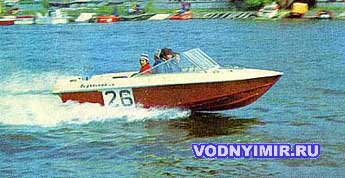
The Crimea-3 motorboat is produced by the Perm Shipyard, according to a project developed by the Neptune Central Design Bureau.
The design of Crimea-3 was preceded by an analysis of the operating experience of serial recreational and tourist planing motorboats. In particular, the most common options for their use were considered. The designers came to the conclusion that the main purpose of the motorboat remains to spend weekends and vacations on it for a family of three or four people. In this regard, the main idea of the project was formulated: to ensure maximum capacity with a sufficiently high level of comfort, convenience and safety of using a motorboat on a tourist trip (during sluicing and in other situations).
The greatest attention was paid to the beneficial use of internal volume. We completely abandoned the side footrests, which made it possible to make the cockpit significantly - 250-300 mm - wider.
A comparison of the Crimea-3 with serial motorboats shows that the total volume of luggage compartments on it is 2.5 times greater than, for example, on the Progress-4, which has almost the same dimensions, and the cockpit area is increased by more than a third - by 35%.
Unsinkability
In “3”, the buoyancy reserve is represented by foam plates sealed in sealed plastic packaging. The designers cleverly placed them in the forepeak and in the aft compartment in the locker at the recess. But! Everything is complicated by possible bottom leaks due to its unreliability.
There is no information on the unsinkability of the next version in official sources, but there are negative reviews on the forums about the fragility of the buoyancy blocks. As for stability, everything is clear here: high sides, a fully loaded draft of no more than 30 cm and the ability to cope with various waves create excellent conditions for safe access to the water.
Ride quality
Nelipovtsy did a tremendous job to fully reveal the seaworthiness of the third serial representative. The design allows you to glide quite quickly and easily. Two PMs provide a good power reserve, which, in turn, gives excellent speed characteristics. Convex, keeled, sharp contours in the nose give the motorboat the ability to overcome oncoming waves. The sides do not flood during cross waves. The speed under domestic PM reaches more than 40 km/h, but if it is exaggerated, the bottom hits the water and it quickly and irreversibly fails.
According to the passport, the boat number “4” is capable of sailing in shallow water areas of up to 0.5 m, and the travel range in sea conditions of 1 point is 200 km. It would have excellent driving characteristics if it were not for the constantly breaking water cannon. In contrast to this device, the body beautifully conquers the waves. A car engine gains speed in a short period of time, and the transition to planing is almost imperceptible. Full contours above the waterline in the bow eliminate yaw.
The unique ability of the craft is that it can approach the shore at the lowest speeds, and also refloat, simply washing it away with the pressure of water. The advantages include maneuverability, cross-country ability, and a short braking distance of 6-7 m. In the stern, beveled sections of the chine increase agility.
General description of the boat "Crimea"
The production of the Crimea motor boat began in 1970. Over time, the design was modernized and the Crimea-M model appeared. After the improvement, the boat has several features that were not present in the original “Crimea”:
- the strength of the entire body has been increased;
- the number of auxiliary elements for passengers has been expanded;

The production of the Crimea motor boat began in 1970
- a “glove compartment” with good capacity appeared;
- dashboard expanded;
- the bottom has more powerful and expanded U-shaped frames;
- redesigned engine compartment and transom for increased performance and rigidity;
- added self-draining recess (in some models).
The type of contours does not differ; accordingly, the external differences are insignificant. The production of the standard modification was carried out by the plant in Khabarovsk, and the improved model was produced by Perm. Both models were produced until the 90s, discontinued in the middle of the decade.
Both models are made of aluminum with magnesium additives. The use of aluminum-magnesium alloy (AMg5) ensures high strength of the housing. Argon arc welding is used to connect structural elements to each other. Thanks to the use on the right, the structure is highly resistant to corrosion; accordingly, the boat can be used for sea travel.
In the bottom area the boat has a plating thickness of 2 mm. At the edges, on the deck and sides, the thickness is 1.5 mm. Most prefabricated parts are made by stamping from sheets. The hull of the standard "Crimea" is manufactured using a mixed method - frames and stringers have longitudinal directions. The Crimea-M boat uses a more durable bottom with P-shaped profile frames.
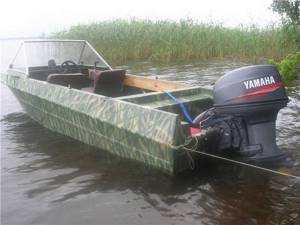
Boat Crimea view from the transom
The Crimea boat has convex-keeled contours in the bottom area to impart optimal hydrodynamic properties. The zygomatic splash guard ensures optimal movement speed and minimal vibrations, shaking, and splashes. The plane of the splash guard is 90° relative to the side. The Crimea boat has numerous videos on use that will help a potential buyer determine the quality of the ride.
The characteristics of the Crimea boat provide the ability to travel at distances of up to 3 km from the coastline. The design is designed for use at sea; accordingly, the boat can withstand waves up to 75 cm high. Aluminum boats “Crimea” are designed to sail in waves up to 3 points. When used as a pleasure boat, it is recommended to install an engine of up to 40 hp. pp., this is enough for long trips.
The Crimea boat allows travel with 4 people, as can be seen in the photo. In weight equivalent, the boat can withstand 400 kg of useful mass. In the cockpit area there are seats for passengers measuring 2.05 x 1.3 m. On the bow there are 2 independently adjustable backrests; they have a removable mechanism. If necessary, switch to oars, the backrests lean back. The backrest at the stern is designed for 2–3 seats and is made in one piece. When tilted, you can access the trunk. All seats are removable and can be used to create a soft and spacious bed for 3 people.
There is an additional trunk in front, closed by a special door with a folding mechanism. The design allows the driver and front passenger to sit freely. Safety glass is made from flat panels.
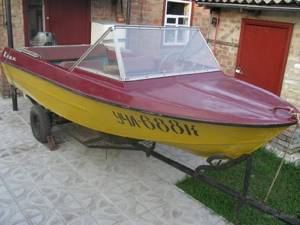
The characteristics of the Crimea boat provide the ability to travel at distances of up to 3 km from the coastline
The Crimea motor boat is distinguished by its characteristics in terms of a waterproof engine compartment; a special cover is installed in it. It absorbs sound for passenger comfort and prevents water ingress. Drainage facilities are provided in the bulkhead and transom area. The transom design has a spring-loaded plug that can open even during a trip. Additionally, the engine compartment contains a tank. The transom dimensions allow the installation of 2 motors.
The steering device is used for control:
- the steering wheel is located in front of the cockpit, on the left side;
- sturtrosovye wires for fastening with four hinged blocks;
- a spring-type compensator that prevents tension in the steering cable;
- Additionally, the device is equipped with a remote control, which allows you to give gas or turn on reverse.
The design is based on 4 key sections. The dimensions of the Crimea boat can be reduced by disassembling it, but argon welding is used for connection, which processes the sheets along the entire perimeter of the bilge angles. To strengthen the sides, pockets with increased rigidity are built in; they also perform the task of securing the seats. Additionally, small items from equipment can be stored in the pockets. The length of the Crimea boat can be reduced by 4 times by disassembling it. All sections of sheet metal use lap joints.
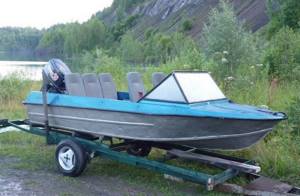
Motor boat "Crimea"
Standard hull painting involves 2 main colors: red - this is used to paint the Crimea boat up to the fender level, and the bottom and side are yellow. The inside of the metal is covered with gray enamel with a light blue tint.
Refinement of the Crimea boat to ensure unsinkability required the introduction of foam floating blocks, which are fixed under the stern or on the bow near the stem. Even if completely flooded, the boat remains above the water level.
The bottom has a slight deadrise, which ensures comfortable movement and planing even under heavy loads. At maximum load, overall maneuverability decreases.
Speed table
| Name of PM series motorboat “3” | Number of motors | Loading, kg | Speed, km/h |
| Mercury 50 | 1 | 380 | 53 |
| Yamaha 90 | 1 | 250 | 72 |
| Whirlwind–25 | 1 | 180 | 30 |
| Whirlwind–25 | 2 | 180 | 43 |
| Whirlwind–25 | 1 | 350 | 25 |
| Whirlwind–25 | 2 | 404 | 39 |
| Whirlwind–25 | 2 | 500 | 39 |
| Whirlwind-30 | 1 | 180 | 40 |
| Whirlwind-30 | 1 | 350 | 35 |
| Whirlwind-30 | 1 | 450 | 30 |
| Neptune–23 | 1 | 180 | 30 |
| Neptune–23 | 2 | 180 | 43 |
| Neptune–23 | 1 | 350 | 26 |
| Neptune–23 | 2 | 500 | 40 |
Under the motor
The Crimea 3 version, designed for a PM pair, gives a good speed of Neptune - 30 km/h and up to 40. The payload-to-speed ratio with a Vikhrey-M pair is 180x43, 500x40 kilograms per km/h. PM power 60 l. With. not recommended for reasons of hull safety.
The difference between “4” is an interesting combination of a taxi-type engine from a “Volga” and a water cannon of the design team’s own design. The operating speed of 2900 rpm is equivalent to 70 horsepower. The engine life in this mode is up to 800 hours, and the fuel consumption is 19 liters per hour. The four-blade wheel has a pitch of 250-260 mm. Mooring thrust - 385 kgf.
Torque is transmitted to the wheel shaft using a spur gear within a 1:1 ratio. The shaft is as horizontal as possible. Therefore, the water pipeline is not long, flat, and has low hydraulic resistance. The water flow goes along the shaft and does not create unnecessary turbulence. The water pipe is made of fiberglass. The impeller rotates in a steel ring glued into the water conduit. The larger diameter hub creates uniform flow acceleration.
Tuning
Since the watercraft of both variations are controversial, having equally strong pros and cons, tuning can be endless and limitless.
Option “3” has the most rewarding and fundamental change - completely replacing the bottom and corners. Craftsmen who have decided to take this rather expensive step note the restored balance of driving performance and speed, as well as the increasing service life of the product. Raising the transom with your own hands, replacing the windshield and control cables are little things that improve the quality of walking on the water.
With four it is a little more difficult. This model is very rare. As a rule, the master “collaborates” with the one he gets. Those who come across a water cannon, but its habitat will be medium or deep water, convert it into a PM. If everything coincides, then the first step is to completely change the water cannon, power set, and decide on the irreplaceability of the lockers and cabin. The cockpit is being reworked.
Reviews
If for the first motorboat in question there is enough information on forums from its owners, then for the second the information is old, there are almost no discussions. But, in general, the reviews are warm. They unanimously praise the contours and hydrodynamics of the hull and criticize the build quality, as well as the material used. Perhaps the shortcomings arose due to the lack of a unified continuous production of serial models. Individual processes took place in completely different workshops and even factories. In order to get a faithful assistant for many decades, you will have to invest your time, effort and finances in modifications.
